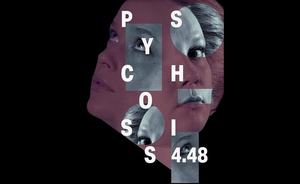BWW Finland Review: SARAH KANE'S 4.48 PSYCHOSIS AT KOKO THEATRE
The show is much, but bearable and moreover brings you into the world of a sick person.

Director: Moe Mustafa
Translation: Michael Baran
On Stage: Sara-Maria Heinonen, Katimari Niskala
Light Design: Roy Boswell
Sound and video projections: Moe Mustafa
Scenographic assistant: Matti Collan
A ticking clock and a simple scenography. Even the performers jeans and hair color varies, but brings harmony: they're here as a unity to bring a meaningful topic alive.
The show is much, but bearable and moreover brings you into the world of a sick person.
And is it just that -- depression, psychosis: a disease among others but still such a taboo.
I myself have gone through depression. Just this summer and fall have I experienced a very rapid healing time since I got diagnosed with an unspesific depression in 2018, following a severe one in the end of 2019. Since then I have got help through medication and therapy and now I can see colors again.
So, in the performance the symptoms that were told were recognisable and the fact that - should I say - all of them were of severe depression brought an interpretation that the subject is now the disease itself, not the idea that the person would actually have all of those.
Even in the physical scenes where the actors were on top of each other I saw as if the other tried to push the other down and from the other just the opposite: to bring the other up.
It was quite hard to tell if it was so but nevertheless it was a strong symbol (at least in my head) to the relationship dynamics of someone with severe depression and the friends/partner/family, etc. who try to help. It's very hard seeing someone fall down and somehow bringing you down with them too. In the same way it's hard to know that you're sick and act and say things that come from your sickness, seeing your loved ones suffering from it.
The performance was very poetic in many ways, combining sound and video projection, text that was spoken aloud by two performers at the same time and sometimes in parts.
It was hard not to cry. It brought so many themes and emotions on stage from the depths, gloomy pits of the depressed mind.
And indeed, it's not your fault.
Interpretation was at times hard because the performance had no strict frames or story, for it brought snippets and abstract experiences and thoughts for us to see. Nevertheless it succeeded to grasp and show/evoke feelings, something valid of depression and psychosis.
As someone who has just recently gotten their heads up from the deeps it was very contradicting to watch. The nurse/doctor character and their sayings were very recognizable and all the sentences they stated, but at the same time I understood and agreed with their message (not necessarily the blunt way they said them). This was hard, because naturally the audience is on the side of the sick one.
The doctor is right in many ways, but the sick one doesn't understand it. Depression is the illness of the mind where all the cognition and thoughts linger. That's why it's so deceptive and hard to manage.
My favorite scene and the most impacting one was the one where the other performer ran and the other stood in the middle of the running circle. It combined action and strong text which rarely is a success but now did gave the right essence on stage for us to gaze and experience.
We should normalize closing eyes or why not closing ears at some points in theatre, but this time I did close eyes. I wanted to focus on the text and it was enough, the visuals were too much. But in the right way.
There was a little detail I would have changed: in the beginning Katimari Niskala had a little monologue where they stood straight towards the audience. Then they proceeded to sit in the same way: face towards the audience. The doctor performed by Sara-Maria Heinonen sat sideways to the audience. And here's the key: the chairs didn't point at each other, sideways, so if the patient would have sat sideways towards the doctor they still would have lacked connection! I would have prefered that because we already had a long scene of seeing the patient's face, emotions and pain. And because the dialogue scene was so based on text and different ideas it would have worked in that way too.
All in all Psychosis is hard to manage but is worth it. The team has done great work in bringing the harshness alive. The show doesn't bring katharsis but reminds us to be emphatic and remember that we can never know the things the other goes through.
Reader Reviews

Videos
